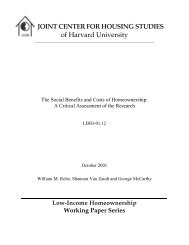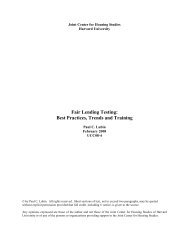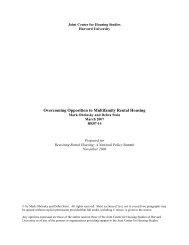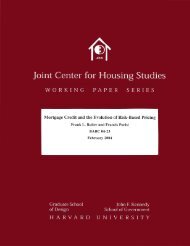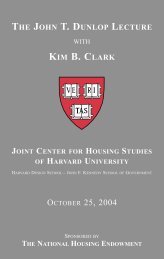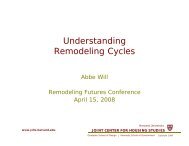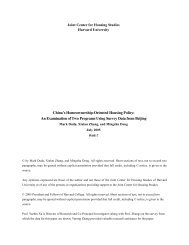please do not cite or circulate without permission of the authors
please do not cite or circulate without permission of the authors
please do not cite or circulate without permission of the authors
You also want an ePaper? Increase the reach of your titles
YUMPU automatically turns print PDFs into web optimized ePapers that Google loves.
launched soon after. Like <strong>the</strong> Nehemiah Program, <strong>the</strong> New Homes Program also<br />
developed new, aff<strong>or</strong>dable, owner-occupied homes in distressed communities. Typically,<br />
<strong>the</strong>se homes are built by private, pr<strong>of</strong>it-motivated developers selected by <strong>the</strong> city and <strong>the</strong><br />
Housing Partnership. But unlike Nehemiah, <strong>the</strong> Partnership has <strong>not</strong> typically built on<br />
large contiguous lots. M<strong>or</strong>e than three-quarters <strong>of</strong> <strong>the</strong> Partnership projects are less than<br />
100 units, many <strong>of</strong> <strong>the</strong>m packages <strong>of</strong> small, infill sites grouped toge<strong>the</strong>r to make up a<br />
project (Orlebeke 1997). What is m<strong>or</strong>e, <strong>the</strong> Partnership has typically developed two- and<br />
three-family homes that include an owner’s unit plus one <strong>or</strong> two rental units.<br />
In part because <strong>of</strong> this different approach to design and construction, <strong>the</strong><br />
Partnership projects have tended to be m<strong>or</strong>e costly. Acc<strong>or</strong>ding to one 1988 study <strong>of</strong> 10<br />
Partnership projects, per-unit costs during <strong>the</strong> 1980s ranged from $57,000 to $137,000<br />
(Orlebeke 1997). The projects were sold in turn to slightly higher income households<br />
than <strong>the</strong> Nehemiah Program homes. In all Partnership projects, <strong>the</strong> city has provided <strong>the</strong><br />
land at a nominal cost ($500 per lot) and has given a $10,000 subsidy per home; <strong>the</strong> State<br />
Aff<strong>or</strong>dable Housing C<strong>or</strong>p<strong>or</strong>ation has provided an additional $15,000 per home (Donovan<br />
1994).<br />
By June <strong>of</strong> 1999, <strong>the</strong> Partnership New Homes program had added 12,590 new<br />
homes to New Y<strong>or</strong>k City’s b<strong>or</strong>oughs. Like <strong>the</strong> Nehemiah Program, <strong>the</strong> construction has<br />
been concentrated in Brooklyn and <strong>the</strong> Bronx, but roughly one-quarter <strong>of</strong> <strong>the</strong> homes have<br />
been built in New Y<strong>or</strong>k’s o<strong>the</strong>r three b<strong>or</strong>oughs.<br />
Choosing Locations<br />
In testing <strong>the</strong> impact <strong>of</strong> new housing on surrounding areas, <strong>the</strong>re is always some concern<br />
about site selection. In this case, f<strong>or</strong> instance, <strong>the</strong> city may have aimed to select “strong”<br />
sites f<strong>or</strong> <strong>the</strong>se programs, where <strong>the</strong>y believed property values were beginning to increase<br />
(<strong>or</strong> at least had some hope <strong>of</strong> <strong>do</strong>ing so). However, even if <strong>the</strong> city had wanted to choose<br />
promising sites, <strong>the</strong>re were considerable constraints in <strong>do</strong>ing so. First, <strong>the</strong> site had to be<br />
owned by <strong>the</strong> city, which meant it would have had to be aban<strong>do</strong>ned by its previous owner<br />
and vested in an in rem proceeding f<strong>or</strong> delinquent property taxes. The city’s stock <strong>of</strong><br />
aban<strong>do</strong>ned properties was overwhelmingly concentrated in its po<strong>or</strong>est neighb<strong>or</strong>hoods<br />
(Scafidi, Schill, Wachter, and Culhane 1998). Second, in <strong>the</strong> case <strong>of</strong> <strong>the</strong> Nehemiah<br />
Program, <strong>the</strong> land had to be a large, mostly vacant, contiguous parcel <strong>of</strong> land.<br />
In any case, interviews with city <strong>of</strong>ficials suggest that <strong>the</strong> city did <strong>not</strong> give its best<br />
5



